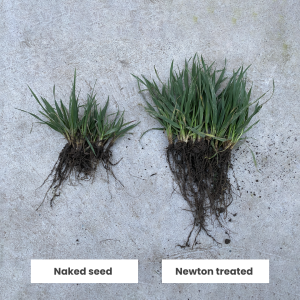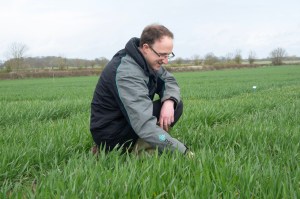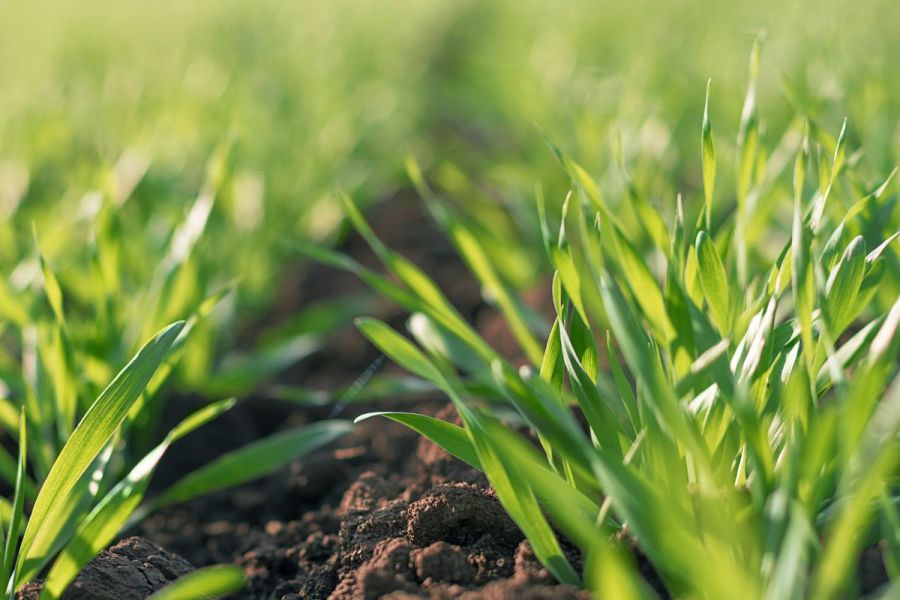Optimising crop health begins long before establishment – it starts with the seed. CPM explores how a biostimulant seed treatment can help plants to overcome challenging conditions right from the off.
“Sowing a healthy, vigorous seed forms the foundation of a successful crop.”
By Janine Adamson
With plant breeders advancing genetics to offer improved traits at a fast pace, attention has shifted to one of the earliest of crop management decisions – choosing the best seed and making the most of it.

Optimising seed health is the number one action you can undertake to achieve a more sustainable start, both environmentally and economically, says Stuart Sutherland.
And because crop production is highly unpredictable throughout each season, Interagro’s Stuart Sutherland says focusing on what can be controlled, starting at the seed, is one way to offset external variables.
“Crop and food production is becoming increasingly stressful thanks to rising input costs, loss of authorised plant protection products and extreme weather conditions. However, optimising seed health is the number one action you can undertake to achieve a more sustainable start, both environmentally and economically,” he says.
Stuart explains that because a crop can be challenged from the moment it’s in the ground, from a lack of rainfall to poor availability of nutrients, the aim should be to achieve a more self-sustaining plant from the beginning.
“Not only does this help to successfully establish a crop, but it also contributes towards other goals such as reducing synthetic nitrogen applications or finding alternatives to chemical inputs,” he says.
But what does it take to achieve a healthy seed and therefore a robust plant? According to Dr Matthew Kerton, wheat breeder at DSV, it’s being adequately armed to overcome the threat of disease. “Farmers understand the role of disease resistance when considering which variety to grow, and this will only become more prevalent as pathogens adapt and plant protection products are revoked.
“The genetic potential of a variety is important because it comes in to play when weather or other pressures prevent optimal timings of spray applications – it helps to maintain green leaf area and progresses to yield potential,” he says.
But this can’t be relied upon alone. Matthew stresses that variety choice must work hand-in-hand with IPM to achieve optimum results and to safeguard the hard-earned genetic potential.
“Crop rotation, soil cultivation choices, nutrient management, and pre-sowing applications of manure all interact with crop genetics, with some varieties performing better than others. This also includes drilling date, which is often dictated by weed, pest or disease pressure, or weather conditions. It’s important to not neglect the impact this all has on performance.”
As well as safeguarding genetic traits, implementing IPM can have observable plant health benefits too, such as boosted germination rates and vigour. Matthew says although this can be the result of effective seedbed preparation and other variables, seed dressings play a significant role.
“In the past, agrochemical-based seed treatments were used to protect against soil-borne pathogens. But now, innovations are available which can enhance the seed. The vigour of a good variety coupled with surrounding nutrition and stimulation can have a synergistic result,” he says.
Newton seed treatment is one of these innovations. Comprised of unique peptides, it stimulates plants by managing the balance between growth promoting and inhibiting hormones. The result is faster germination, improved root and shoot biomass and a bolstered plant defense system.
According to Stuart, this harks back to optimising seed health which results in stronger, more resilient plants that are less dependent on synthetic inputs. He believes one reason for this is the product’s root-boosting capacity. “Newton helps to build deeper root systems that seek and absorb more moisture, which is particularly beneficial during dry springs or on lighter soils when conditions are challenging.
“By their nature, these bigger root systems are also better placed to capture nutrients, making more use of what’s available to the plant. Because some nutrients aren’t very mobile in the soil, the bigger the root system, the better,” he says.
Work undertaken by Nottingham University confirms this claim – on average, Newton boosts root growth in cereals by 43%, 64% in beans, 28% in peas and 82% in maize. Further research by the university shows this comes into its own during drought-stressed conditions.
“For spring barley, the lab-based trial demonstrated that applications of Newton improved both root (+35%) and shoot growth (+47%), even during a drought scenario. Strong establishment is key to the success of spring crops, which have to be quick out of the blocks to yield well but may face especially challenging environments,” says Stuart.

According to Monty Maule, Newton’s ability to improve root mass works hand-in-hand with seed quality.
Anglia Grain Services’ Monty Maule also commends Newton’s ability to improve root mass, which he believes works hand-in-hand with seed quality. “Sowing a healthy, vigorous seed forms the foundation of a successful crop, so adding a biostimulant dressing such as Newton is a means of maximising its potential.
“We find this can have added benefits for those who farm-save; starting by selecting for the largest quality seed and then adding Newton as a top-up for the root stimulation. Research has shown that a healthy seed is one that roots well and this is what we aim for on behalf of our customers,” he says.
One such farm-saved seed customer is grower Gerry Mee, who farms 220ha of arable cropping in Shropshire, rotating between winter wheat, oilseed rape, spring oats, spring wheat and environmental schemes.
Having been no-till for five years in a quest to improve the farm’s soils, Gerry turned to biostimulants to reduce his reliance on single purpose dressings (SPD). “We’d been playing with biostimulants for a few years but really noticed the difference when applying it in seed treatment form compared with an area which hadn’t received the treatment.
“This year we’re conducting an on-farm trial of Newton plus Beret Gold (fludioxonil)-treated winter wheat compared with Beret Gold alone. Then we’re segmenting the trial plots further to understand if additional benefits can be achieved through applying Bridgeway foliar biostimulant.”
Gerry believes his no-till system benefits from the Newton kick-start because it helps the seed to germinate quickly as well as hunker down in the soil. “We took a spade to the trial plots in February and the root mass was considerably bigger in the wheat crop treated with Newton. Once we’ve taken the crop to harvest, we’ll be able to see if there’s a difference in yield too,” he says.
But it’s not just wheat where Gerry has seen a benefit, he’s also applied Newton to spring oats. “The crop was really fast out of the ground to emerge. I believe spring crops require that little extra to move them on, especially given we’re on sandy soils and June has been very dry.”

Gerry Mee believes no-till systems benefit from Newton’s kick-start because it helps the seed to germinate quickly as well as hunker down in the soil.
According to Monty, the product’s formulation is a benefit worth highlighting. “In the past, biostimulant seed treatments could be difficult to adhere to the seed, which not only produced inconsistent results but also compromised its value for the customer.
“It’s the opposite with Newton – it coats the seed consistently well, whether that’s applied alone, alongside an SPD, or with other chemical options. This flexibility is important given the range of arable systems in operation, from conventional to regenerative,” he says.
Monty says this is even the case for pulses, which can be notoriously difficult to coat due to their hard shell, and that this is important given the lack of alternative options. “Pulses lost their main seed treatment years ago so it’s becoming increasingly difficult to manage diseases such as downy mildew from that perspective.
“This is why improving seed health and therefore the plant’s natural defence system is so important for valuable break crops such as beans.”
As well as improved rooting, Newton helps to build plant biomass to optimise sunlight capture for photosynthesis. This could also prove useful when faced with high grassweed pressure, says Stuart.
“Faster establishment maximises the crop’s competitive nature against weeds which fight for the same space and resources. The unpredictability of this season in particular has bolstered grassweed pressure, demonstrating the importance of using all of the IPM techniques available.”

An on-farm study shows winter oats treated with Newton can emerge two and a half days quicker than untreated seed.
Work undertaken by Nottingham University again confirms this claim – at 7oC, Newton increased germination speed in winter wheat by two days. As for winter oats, regenerative farmer Matt Waldie in Fife reported that when treated with Newton, the crop emerged two and a half days quicker than untreated seed.
Stuart says this demonstrates the power of proactively nurturing those early days. “It’s essential that crops grow quickly while temperatures are milder to establish healthy green leaf area, which makes the most of dwindling daylight hours as we go into winter.
“A healthier plant will be better positioned to withstand overwintering and challenges such as frost heave. Of course, we can contribute to all of this by treating the seed just once with Newton which is incredibly efficient,” he says.

Matthew Kerton says more could be made of the synergistic relationship between crop variety and biostimulant seed treatment through targeted breeding.
As the data and on-farm evidence builds, Monty has found more growers are turning to Newton and retaining loyalty. “We receive a lot of positive feedback for the product, with many using it year-on-year across both conventional and regenerative systems. However, you see the most impactful benefits during tough conditions, which has certainly been the case during recent years.
“The results we’re seeing, and hope to see this harvest, mean we believe it’s just the beginning for our customers and biostimulant seed treatments.”
For the next step, there’s the opportunity to take things even further. Matthew believes more could be made of the synergistic relationship between crop variety and biostimulant seed treatment through targeted breeding.
“DSV has been trialling Newton as a seed coating to discover the differences it can make. We believe to push crops even further towards their potential, plant breeders have to address the genetic interactions that take place in this system.
“If some varieties respond better than others to Newton, there’s genetic variation which means we can begin to breed for the perfect partner for this IPM strategy,” he says.
This article was taken from the latest issue of CPM. Read the article in full here.
For more articles like this, subscribe here.
Sign up for Crop Production Magazine’s FREE e-newsletter here.




